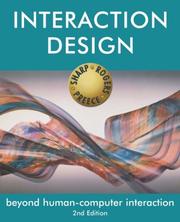Check nearby libraries
Buy this book

This edition doesn't have a description yet. Can you add one?
Check nearby libraries
Buy this book

Previews available in: English
Subjects
Human-computer interactionShowing 1 featured edition. View all 12 editions?
| Edition | Availability |
|---|---|
|
1
Interaction Design: Beyond Human-Computer Interaction
March 23, 2007, Wiley
in English
0470018666 9780470018668
|
aaaa
Libraries near you:
WorldCat
|
Book Details
Table of Contents
Edition Notes
Chapter 1:
1.1 Introduction.
1.2 Good and poor design.
1.3 What is interaction design?
1.4 The user experience.
1.5 The process of interaction design.
1.6 Interaction design and the user experience.
INTERVIEW with Gitta Salomon.
Chapter 2: Understanding and conceptualizing interaction.
2.1 Introduction.
2.2 Understanding the problem space.
2.3 Conceptualizing the design space.
2.4 Theories, models and frameworks.
INTERVIEW with Terry Winograd.
Chapter 3: Understanding users.
3.1 Introduction.
3.2 What is cognition?
3.3 Applying knowledge from the physical world to the digital world.
3.4 Conceptual frameworks for cognition.
Chapter 4: Designing for collaboration and communication.
4.1 Introduction.
4.2 Social mechanisms in communication and collaboration.
4.3 Technology-mediated social phenomena.
INTERVIEW with Abigail Sellen.
Chapter 5: Affective aspects.
5.1 Introduction.
5.2 What are affective aspects?
5.3 Expressive interfaces and positive emotions.
5.4 Frustrating interfaces and negative emotions.
5.5 Persuasive technologies.
5.6 Anthropomorphism.
5.7 Interface agents, virtual pets and interactive toys.
5.8 Models of emotion and pleasure.
Chapter 6: Interfaces and interactions.
6.1 Introduction.
6.2 Paradigms.
6.3 Interface types.
6.4 Which interface?
Chapter 7: Data Gathering.
7.1 Introduction.
7.2 Four key issues.
7.3 Data recording.
7.4 Interviews.
7.5 Questionnaires.
7.6 Observation.
7.7 Choosing and combining techniques.
INTERVIEW with Sara Bly.
Chapter 8: Data analysis, interpretation, and presentation.
8.1 Introduction.
8.2 Qualitative and quantitative.
8.3 Simple quantitative analysis.
8.4 Simple qualitative analysis.
8.5 Using Theoretical Frameworks.
8.6 Tools to support analysis.
8.7 Presenting your findings.
Chapter 9: The process of interaction design.
9.1 Introduction.
9.2 What is involved in interaction design?
9.3 Some practical issues.
9.4 Lifecycle models: showing how the activities are related.
INTERVIEW with Gillian Crampton Smith.
Chapter 10: Identifying needs and establishing requirements.
10.1 Introduction.
10.2 What, how, and why?
10.3 What are requirements?
10.4 Data gathering for requirements.
10.5 Data analysis.
10.6 Task description.
10.7 Task analysis.
INTERVIEW with Suzanne Robertson.
Chapter 11: Design, prototyping and construction.
11.1 Introduction.
11.2 Prototyping and construction.
11.3 Conceptual design: moving from requirements to first design.
11.4 Physical design: getting concrete.
11.5 Using scenarios in design.
11.6 Using prototypes in design.
Tool support.
INTERVIEW with Karen Holtzblatt.
Chapter 12: Introducing evaluation.
12.1 Introduction.
12.2 The why, what,, where and when of evaluation.
12.3 The language used to describe evaluation.
12.4 Evaluation approaches and methods.
12.5 Evaluation studies.
12.6 What did we learn from the case studies?
Chapter 13: An evaluation framework.
13.1 Introduction.
13.2 D E C I D E: A framework to guide evaluation.
Chapter 14: Usability testing and field studies.
14.1 Introduction.
14.2 Usability testing.
14.2.1 Usability testing of a large website.
14.2.2 Conducting experiments.
14.3 Field studies.
INTERVIEW with Ben Shneiderman.
Chapter 15: Analytical evaluation.
15.1 Introduction.
15.2 Inspections: heuristic evaluation.
15.3 Inspections: walkthroughs.
15.4 Predictive models.
INTERVIEW with Jakob Nielsen.
Classifications
ID Numbers
Community Reviews (0)
Feedback?History
- Created April 29, 2008
- 19 revisions
Wikipedia citation
×CloseCopy and paste this code into your Wikipedia page. Need help?
| December 19, 2023 | Edited by ImportBot | import existing book |
| January 15, 2023 | Edited by ImportBot | import existing book |
| January 2, 2023 | Edited by MARC Bot | import existing book |
| November 15, 2022 | Edited by ImportBot | import existing book |
| April 29, 2008 | Created by an anonymous user | Imported from amazon.com record. |









